
A straight-three engine is a three-cylinder piston engine where cylinders are arranged in a line along a common crankshaft.
Triumph Engineering Co Ltd was a British motorcycle manufacturing company, based originally in Coventry and then in Meriden. A new company, Triumph Motorcycles Ltd, based in Hinckley, gained the name rights after the end of the company in the 1980s and is now one of the world's major motorcycle manufacturers.

The Triumph Rocket III is a three-cylinder motorcycle made by Triumph Motorcycles Ltd. At 2,294 cc (140.0 cu in) it had the largest-displacement engine of any production motorcycle until 2019 when Triumph released the Triumph Rocket 3.

The Triumph Thunderbird is a British motorcycle that was introduced by Triumph back in 1949 and produced in many forms until 1966. The name was used three more times for new and distinct Triumph models.

The Triumph Trident and BSA Rocket 3 was a technically advanced, high-performance roadster motorcycle made by Triumph Engineering and BSA from 1968 to 1975, and sold under both the Triumph and BSA marques. Alongside the Honda CB750, and later the two-stroke Kawasaki triples, it brought a new level of sophistication to street motorcycles, marking the beginning of the superbike era. The Honda CB750 overshadowed the Trident to be remembered as the 'first superbike', in spite of the Triumph Trident actually debuting before the Honda by a few weeks.
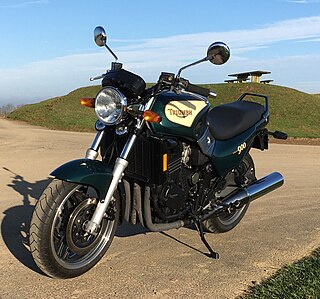
The Triumph Trident is a three-cylinder motorcycle of either 750 cc or 900 cc capacity. These bikes were produced from 1991 to 1998 at Hinckley, Leicestershire, England, by Triumph Motorcycles Ltd, the successor business to the defunct Triumph Engineering at Meriden Works, Warwickshire, England.
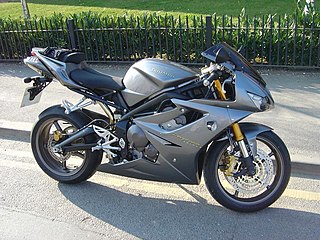
The Triumph Daytona 675 is a three-cylinder sport bike built by Triumph Motorcycles. It replaced the four-cylinder Daytona 650. The 675 proved to be remarkably light, nimble and powerful; at a maximum of 128 bhp it was also very quick, and it was very successful against the Japanese 600 cc competition. In 2016, Triumph ceased production of the base model Daytona 675 citing diminishing demand for super sport bikes and increasingly strict European emission standards. Triumph continued to produce the up-spec Triumph Daytona 675R model until the 2018 model year. Triumph filed a new trademark for the Daytona, fuelling rumors that there may be a future version sporting the new 765 cc engine. It turned out to be a 660, released in 2024.
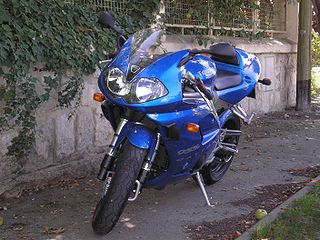
The Triumph Daytona 955i is a sport bike manufactured by Triumph from 1997 to 2006. It was powered by a 955 cc (58.3 cu in) liquid cooled, inline three four stroke engine. The bike was launched in 1997 as the Triumph T595 Daytona and renamed Triumph Daytona 955i in 1999.
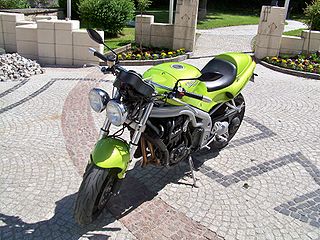
The Triumph Speed Triple is a series of motorcycles produced by Triumph Motorcycles. The 1994 Hinckley Triumph was one of the first motorcycles produced in the streetfighter style. The style originated with bikers who, having crashed their race replicas, put the bikes back on the road without fairing, and has since become popularised.
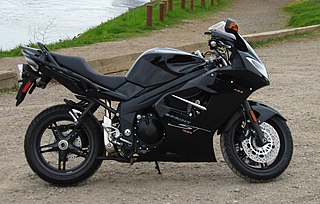
The Triumph Sprint ST is a sport touring motorcycle manufactured in the United Kingdom by Triumph between 1999 and 2010. Sporting a 1050cc 4-stroke three-cylinder engine, an alloy-beam frame and a single-sided swingarm, the Sprint ST competed effectively in the market against the Honda VFR800. In 2010 the Sprint ST was succeeded by the Triumph Sprint GT.

The Triumph Street Triple is a standard motorcycle made by Triumph Motorcycles since 2007. The bike is closely modelled on the Speed Triple 1050 but uses a re-tuned inline three cylinder 675 cc engine from the Daytona 675 sport bike, which was released in 2006.

The Triumph Tiger 955i (T709EN) is a dual-sport motorcycle that was produced by Triumph Motorcycles between 2001 and 2006.

Triumph Motorcycles Ltd is the largest UK-owned motorcycle manufacturer, established in 1983 by John Bloor after the original company Triumph Engineering went into receivership. The new company, initially called Bonneville Coventry Ltd, continued Triumph's lineage of motorcycle production since 1902. They have major manufacturing facilities in Thailand.
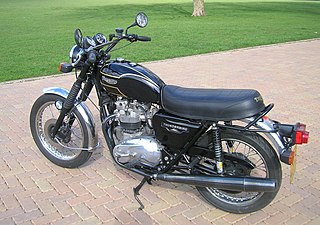
The Triumph TR65 Thunderbird is a motorcycle made by the Triumph worker's co-operative at the Meriden factory from 1981 to 1983. The TR65 was a reintroduction of the Triumph Thunderbird model name first used on the original 6T Thunderbird of 1949. A short stroke model, the Daytona 600 was designed in 1983 but not produced.
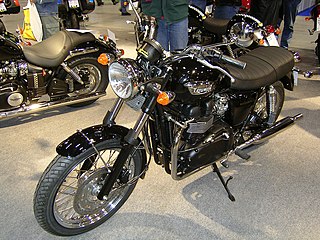
The Triumph Bonneville 790 cc is a British motorcycle that was designed and built in Hinckley, Leicestershire by Triumph Motorcycles Ltd between 2001 and 2007, when the engine size was increased to 865 cc.

The original Tiger 900, manufactured by Triumph Motorcycles Ltd was introduced in 1993 and remained in production with minor improvements until 1998. Known to its fans as the 'Steamer', a nickname identifying it as a Hinckley Tiger, not a Meriden Tiger, and also distinguishing it as a carburettor, not fuel injected engine, this 885 cc dual sport motorcycle sold in comparatively small numbers in its native UK, but with some relative success in the US and continental Europe, particularly Germany.

Slippery Sam is a British production class racing motorcycle from the early 1970s that used a carefully prepared version of the 750 cc Triumph Trident ohv (pushrod) three-cylinder engine. The "Slippery Sam" name was acquired during the 1970 Bol d'Or, a 24-hour race for production-based machines held in France, when engine difficulties and escaping oil covered the bike of Triumph employee Percy Tait and co-rider Steve Jolly who managed to finish in fifth place to winners Paul Smart and Tom Dickie on another works Trident.

The Triumph Sprint 900 is a sport touring motorcycle manufactured by Triumph from 1991 to 1998 at their factory in Hinckley, Leicestershire. Styled by Rod Skiver, the Sprint was powered by an 885 cc (54.0 cu in) liquid-cooled, inline-three four stroke engine. The engine was a similar triple to that in the Triumph Trident 900 and many of the cycle parts were interchangeable with the Trident.

The Triumph Daytona and Daytona Super 3 is a three or four-cylinder British sports motorcycle. These bikes were produced from 1991 to 1996 at Hinckley, Leicestershire, England, by Triumph Motorcycles Ltd, the successor business to the defunct Triumph Engineering at Meriden Works, Warwickshire, England.



















